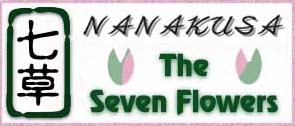About Nanakusa
Everybody knew the word nanakusa (the
seven herbs), but how many can tell all the names of nanakusa ?
The only thing we know about nanakusa is nanakusagayu.
So we decided to study what nanakusa is. We learned there are also
nanakusa
of autumn and each herb has it own medical effect on our health. We also
learned there is a poem on nanakusa in Many ush ush (A Collection of 10,000 Verses) as
old as in the 8th century. (A Collection of 10,000 Verses) as
old as in the 8th century.
We are very much impressed with the wisdom of the ancient people who
discovered the effects of these plants and has been delivering the wisdom
to younger generation through the traditional events as nanakusagayu
in spring, flower viewing in autumn and poems or songs. It is interesting
to find out from the old poem that the ancient people called kikyou
(Chinese blood bellflower) asagao (morning glory)., and
susuki (Eulalia) obana (male flower).
Kanako Tsunoda, Shiho Wakiya, Michiko Sato, Kayo Nakajima
|
Season
early spring, autumn
Purpose
[the seven spring herbs]@@young seedlings used for food
[the seven autumn flowers]@@decorative plants
The origin
based on ancient Chinese customs
Origin of nanakusa-gayu
When the people used to pull up young pine trees(komatsu ) on
nenohi
(the day of the rat in early January, they also picked wild grasses and
made hot
soup.)
Nenohi is sometimes called nanakusa.
In the Heian period (794`1192A.D.), nanakusa-gayu was served
on the
morning of January 7 as an imperial palace ceremony.
Even now nanakusa-gayu is served on January 7.
# Refer to Japanese Calendar and Zodiacs
Nanakusa-gayu [seven herbs rice gruel ]
Rice gruel cooked with the seven herbs of spring -seri, nazuna, gogy ,
hakobe, hotokenoza, suzuna, suzushiro. ,
hakobe, hotokenoza, suzuna, suzushiro.
Traditionally it is cooked on January 7, due to the belief that these herbs
will remove evil from the body and prevent illness.
Why we should eat 'nanakusa-gayu'
To prevent all kinds of diseases, and drive evil away.
On New Year's Day we tend to eat and drink too much, which upsets our
stomachs.
So after the feasts of the New Year, eating light healthy gruel with lot of
vitamins is good for us.
To gain new vitality.
๔๔ The song of "the seven spring herbs" ๔๔
iharu no nanakusa no utaj
| Se/ri/@Na/zu/na | 5 Go |
| Go/gyo/u/@Ha/ko/be/ra | 7 Shichi |
| Ho/to/ke/no/za | 5 Go |
| Su/zu/na/@Su/zu/shi/ro | 7 Shichi |
| Ko/re/zo/@Na/na/ku/sa | 7 Shichi |
by Kigin Kitamura
This is a type of Japanese poem with 31 syllables called tanka
It's a traditional Japanese poem, formed in this order : 5 syllables, 7
syllables, 5
syllables, 7 syllables, 7 syllables.
Kigin Kitamura@(1624`1705A.D.j
A poet and a scholar of the Edo period i1603`1867A.D.j
Most famous work : Kogetsush , which analyzes
'Genji
Monogatari' , which analyzes
'Genji
Monogatari'
๔๔ The song of "The seven autumn flowers" ๔๔
iaki no nanakusa no utaj
Tanka@
| Akinononi |
5 Go |
| Sakitaruhanao |
7 Shichi |
| oyobiori |
5 Go |
Kakikazoureba
@i= means to count one's finger) |
7 Shichi |
| Nanakusanohana |
7 Shichi |
Sedouka@
|
Haginohana@
| 5 Go |
|
Obanakuzubana
| 7 Shichi |
|
Nadeshikonohana@
| 7 Shichi |
|
Ominaesi@
| 5 Go |
|
Matafujibakama@
| 7 Shichi |
|
Asagaonohana@
| 7 Shichi |
by Okura Yamanoue-no@
The orange parts are rhymes.@
Okura Yamanoue-no@ i710`733HA.D.j
A poet of the Nara period (710`794A.D.)
75 works are compiled in his 'Man|y sh sh ' '
m11- ch ka, 63- tanka,
1-sedoukan ka, 63- tanka,
1-sedoukan
Most famous work : Hinky |mon |mon ka ka
Sedouka@
It's in the style of waka formed in this orderF5
syllables, 7
syllables, 7 syllables, 5 syllables, 7 syllables, 7 syllables.
Originally it means 'meguru'mrotationn. The first half is a
question, the
second half is a reply.
|

 ush
ush (A Collection of 10,000 Verses) as
old as in the 8th century.
(A Collection of 10,000 Verses) as
old as in the 8th century.

 ka
ka
